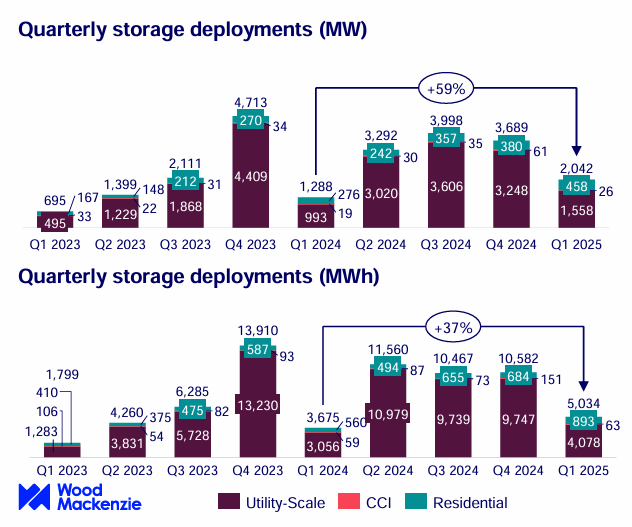US Energy Storage Hits New Q1 Record with Over 2 GW Installed
The utility-scale energy storage market accounted for 1,558 MW, up 57% YoY
June 27, 2025
Follow Mercom India on WhatsApp for exclusive updates on clean energy news and insights
The U.S. energy storage market added more than 2 GW across all segments in the first quarter (Q1) of 2025, marking the highest Q1 on record, according to the latest U.S. Energy Storage Monitor report from the American Clean Power Association and Wood Mackenzie.
The utility-scale energy storage market added 1,558 MW of capacity in Q1 2025, a 57% year-over-year (YoY) increase. Deployments rose 33% to 4,078 MWh from 3,056 MWh in the same period of the previous year.
California led with 457 MW of installed capacity, followed by Indiana with 256 MW. Arizona and Texas added 255 MW each, and Nevada 200 MW. Texas led this quarter in terms of project count with eight projects installed, followed by California, where the biggest project, with 240 MW of capacity, was brought online.
Residential energy storage posted the highest relative growth across all segments. Installed power capacity rose 82% to 458 MW in Q1 2025 from 252 MW in Q1 2024. Energy capacity grew to 893 MWh from 516 MWh, a 73% YoY increase. The residential segment continued to grow with expansion in the California and Puerto Rico markets. These two markets contributed 74% to the overall growth.
Illinois emerged as a new market with net billing, although attachment rates have not yet reached the anticipated levels. Like with other segments, there are continued efforts across the country to take advantage of existing tax credits this year while they remain available.
The commercial, community, and industrial (CCI) segment also recorded gains. Power capacity additions increased to 26 MW in Q1 2025, up from 19 MW in Q1 2024, representing a 33% jump. Energy capacity additions increased by 6%, rising to 63 MWh from 59 MWh over the same period.
The California CCI sector is struggling as the state faces challenges from the slow adoption of NEM 3.0 projects. Additionally, the limited number of new community storage projects this quarter hindered growth in the segment.
A key growth driver in this quarter was the decline in system costs. The average price of utility-scale battery systems fell to $874/kW in Q1 2025, down from $1,165/kW in Q1 2024. This represents a 25% reduction, which has helped improve the economics of storage projects and broadened deployment across market segments.
The pipeline for future utility-scale projects also expanded. By the end of Q1 2025, the total utility-scale segment pipeline stood at 603 GW. This pipeline includes 127 GW of projects in Wood Mackenzie’s database and 476 GW in interconnection queues. The total represents a 12% increase from Q1 2024, which had a pipeline of 538 GW.
Outlook
Across all segments, 15.2 GW/48.7 GWh of capacity will be added in 2025. In the near term, all segments of the energy storage market are expected to face policy-related challenges. Despite this issue, cumulative installations are projected to reach 79.8 GW and 289.4 GWh.
This year is on track to set new records for utility-scale storage, with a 22% YoY anticipated growth rate. However, political uncertainty is likely to dampen progress in 2026, with the utility-scale segment expected to decline by 29% compared to 2025.
Throughout Q1 and Q2, fluctuating tariff rates have restricted battery procurement from China. Unless there are changes to the Investment Tax Credit (ITC) or Section 45X, the market is forecast to rebound in 2028 and 2029.
Over the next five years, cumulative installations are expected to match earlier projections despite short-term volatility. Long-term demand is driven by strong interest in renewables from hyperscalers, capacity constraints in independent system operators, and state-level targets.
The residential storage market is set to expand by 45% in 2025. This growth will be supported by stabilized tariffs, continued price declines, and program expansions. The net billing transition in select regions will also contribute to higher adoption rates.
Growth in the CCI segment remains limited. Lower-than-expected uptake in California, along with ongoing uncertainty surrounding tariffs and policy measures, has slowed momentum. The segment continues to face difficulties due to the complexity of applications and weak project economics. Any further reduction in tax credit availability could place additional pressure on its growth trajectory.
House Reconciliation Bill Impact
Provisions in the House reconciliation bill are expected to impact the energy storage sector. The projected range of possible outcomes over the next five years spans a 29.5 GW difference between the high and low scenarios.
In the high case, an additional 8 GW of storage capacity would be deployed over the next five years. This outlook assumes that federal clean energy tax credits remain in place, no new tariffs are introduced under the Trump administration, and that renewables paired with storage are actively used to meet growing electricity demand. The high case also assumes improvements in financing conditions and fewer interconnection delays.
The low-case forecast predicts a 27% decline in total installations from 2025 through 2029. This scenario assumes that the reconciliation bill passes in its final form in the House of Representatives. Under these conditions, projects would be required to begin construction within sixty days of the bill’s passage and be operational by the end of 2028.
The sudden end of the ITC would lead to widespread cancellations as developers struggle to qualify and financial institutions grow increasingly risk-averse. The low case also expects continued trade friction between the U.S. and China, with tariffs remaining volatile through 2026. These conditions would likely drive up system prices and create further procurement delays. For the residential sector, the assumption is that the tax credit under Section 25D would expire after 2025, including for leased systems.


